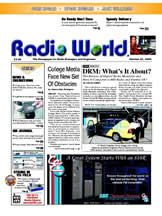
 |
|
|||||||||
|
|
 |
||||||||
 |
Stay Tuned for More About the ins and outs of transmitter tubes by Mark Persons |
Radio
World Article February 1, 2015 |
| You can also see this article at
Radio World Magazine:
http://www.radioworld.com/article/stay-tuned-for-more/274491
Emails: February 17, 2015, from LinkedIn: I continue to enjoy your article in Radio World. I never realized that tubes were evacuated upside down to get some gravity assist in the process. Is that true, or were you just pulling our legs? The article about the stereo 19kHz pilot getting broadcast on an AM transmitter brought back memories of long ago before I went overseas with VOA in '89. I discovered that happening on one of my contract stations while they were taking an off-air FM sports network feed using a cheap run-of-the-mill audiophile FM receiver. As I recall, it put a very noticeable 1 kHz beat note on the second adjacent stations' signals. Charles Lewis, KY4P, West Jefferson, North Carolina. Tube question answer: Evacuating tubes in an inverted position is true and is the best way to do it. Mark. February 13, 2015: Hi Mark, Just wanted to say I checked out you article in the Radio World magazine this month (Feb 1st, 2015). Good Stuff my friend! Never knew what the inside of a ceramic tube looked like before this. And then there's the electron theory of operation inside between the filament and plate. On Behalf of all of us RF numb skulls everywhere; Thanks! Andy Bursaw, WKLK Radio, Cloquet, Minnesota. February 12, 2015: Great article in Radio World on tubes, Mark. I've never seen the inside of a tube! Also, good info on the naming scheme. Thanks. Dan Houg, Station Engineer KAXE Grand Rapids, Minnesota, and KBXE Radio Bemidji, Minnesota. February 8, 2014: Just got my February 1st issue of Radio World yesterday. Good story by the way, looks like some work to break the tube apart. Dave Cox, Brainerd, MN. February 5, 2015: I've framed your article and it now hangs in an honored place on my office wall. Best, Charles S. Fitch, P.E., Avon, Connecticut. February 4, 2015: Hello Mark, Thank you for the most excellent Radio World tech tips article. Interesting, informative to the extreme, and of personal interest to me. After retiring from government work, I became chief engineer at KVMR in Nevada city and KMYC in Marysville California. Now retired in Florida. Again, thanks for showing the tube innards. Jerry Snaper, KG6FDM, Plant City, Florida. February 2, 2015: Dear Mr. Persons: Saw your article on the 4CX5000A tube, published in Radio World this afternoon. EXCELLENT ! This is the type of educational articles I'd like to see published more often in Radio World. Keep writing them. I want to tell you that I appreciate your time to disassemble and photograph the 4CX5000A tube. Never saw what one looked like inside. Thanks for your time to write the article in Radio World. Sincerely, Kent Verbeck. January 30, 2015: I just received my February 2015 Radio World publication. Page 18 & 19 "about the ins and outs of transmitter tubes" by Mark Persons, W0MH. Great article with the history of, and photos showing the Eimac 4CX series tubes (4CX5000A) with cutaways and disassembled tubes. The Tube Collector organization is very alive with hundreds of collectors/members. I'm sure they will enjoy your article. They have a monthly collector magazine covering everything tube. They are a good bunch. 73, John Dilks, K2TQN www.k2tqn.com/ Former Editor Vintage Radio Column, QST Magazine 2000-2014. January 30, 2015: Thanks for
the great article. I passed it along to a student IT employee who has shown
some interest in transmitters and all other things broadcast. January 30, 2015: Hi Mark: I enjoyed your article on high-power tubes. I particularly enjoyed the photos showing the �innards� of a 4CX5000. Although I�ve worked on transmitters, used ceramic tubes were always sent back for rebuild so I�ve never actually seen inside one. Thanks! Bob Weller P.E.
|
|
|
|
Questions? Email Mark Persons: teki@mwpersons.com |
|